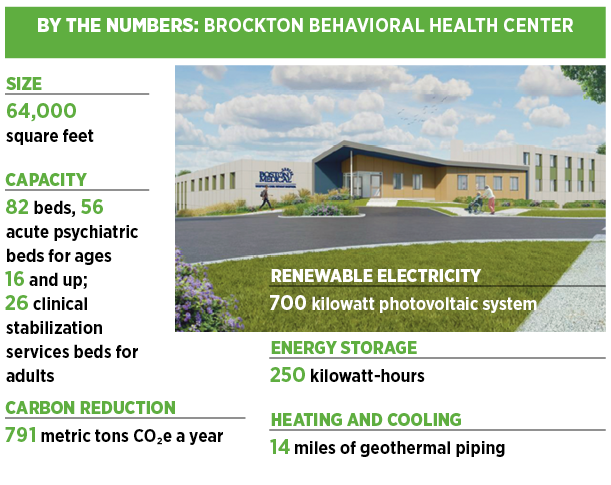Boston Medical Center works toward carbon neutrality
Boston Medical Center (BMC)— New England’s largest safety net hospital—prides itself on offering exceptional and accessible care to its patients. It serves a predominantly Medicaid and Medicare population. It’s also known as Boston’s greenest hospital.

For Bob Biggio, SVP of Facilities and Support Services, BMC’s critical role in serving its community drives the hospital’s sustainability initiatives. “We’re often the safety net that is there to care for our community in their most dire circumstances. And because Boston is built largely on landfill, our city is one of the most vulnerable in the world to the rise of sea water,” he says. “We have to make investments to be able to protect our community.”
The latest investment? A new behavioral healthcare facility in nearby Brockton, Massachusetts, which is bringing critical behavioral health services to the people who need them most.
Building momentum
The healthcare sector is responsible for an estimated 10% of all greenhouse gas emissions in the U.S. When BMC recognized the potential impact on its community and beyond, they took measures to reduce its carbon footprint.
“When we started working on this 10 years ago, we didn’t have a big lofty goal. We just wanted to do the best we could and try to make as much progress as possible,” says Biggio.
A few successful energy efficiency projects during Biggio’s early years at BMC helped create confidence and gather internal support for environmental initiatives. As the successes became evident, he “had more and more team members approach me asking how they could help and get involved. It was like a snowball, and the momentum just kept building,” he explains.
This momentum has resulted in an impressive portfolio of projects, including a:
- Biodigester to compost food waste
- Solar power purchase agreement with a 650-acre solar farm
- 2,700-square foot rooftop farm that supplies organic produce to hospital patients, a food pantry as well as a farmer’s market
- Natural gas-fired cogeneration plant that generates 43% of the hospital’s electricity and 30% of its heat, with reduced carbon emissions
BMC is also a member of the Boston Green Ribbon Commission, an organization working across industries to fight climate change. BMC President and CEO Kate Walsh serves as the chair for the healthcare sector.
Biggio estimates that BMC’s sustainability efforts save $8 million–$10 million annually.
“I’ve tried to be careful and thoughtful about our work to be sure I wasn’t taking financial resources from our mission of caring. Most of our work, if not all, has both reduced our carbon footprint and saved money so we could direct more resources to the care of our community,” he says.
Renovating for a purpose
BMC’s progress has led to its latest major accomplishment in pairing community care with sustainability. In October 2022, BMC opened Brockton Behavioral Health Center, which has two 28-bed inpatient psychiatric units for patients ages 16 and older and a 26-bed clinical stabilization service unit for adults who are in need of step-down treatment for substance use disorder following detox or inpatient care. The center combines BMC’s mental health expertise with the hospital’s addiction treatment models, which have been replicated across the country.
 This health center was designed to create net zero carbon emissions from energy—a first for this kind of facility—thanks in part to a generous $6 million anonymous donation.
This health center was designed to create net zero carbon emissions from energy—a first for this kind of facility—thanks in part to a generous $6 million anonymous donation.
Transforming a former nursing home into a state-of-the-art carbon-neutral health center was no simple task. But BMC drew on the experience it had gained from previous carbon-reduction efforts and support from external partners to navigate obstacles.
The building was renovated to meet modern energy efficiency standards, with LED lighting throughout, and fully electric kitchen and laundry facilities. The facility will be able to generate all the electricity it requires on-site through solar panels on its rooftop and parking canopies. A battery storage system will also help to reduce grid congestion and carbon emissions.
For heating and cooling, a geothermal system was installed with 14 miles of piping supplied by 88 wells, 500 feet deep. By using the renewable energy from within the earth, geothermal systems lower energy costs and carbon emissions while having low maintenance requirements and a long lifespan.
“For Boston Medical Center, we can’t truly care for our community without also caring for the environment of our community,” Biggio said. “Our commitment to sustainability is a foundational prerequisite to providing the best medical care and wraparound supports for our patients. The savings we’ve achieved goes right back into patient care as well.”
Decarbonization Is Key to Reducing Healthcare’s Carbon Footprint
Health Care Without Harm indicates that, as an industry, healthcare accounts for 4.6% of total greenhouse gas (GHG) emissions worldwide and 8.5% of U.S. emissions. Policymakers and the financial industry have placed an increased emphasis on organizations to formally commit to reducing greenhouse gas emissions. Understanding healthcare’s various sources of emissions is key to determining how to begin reducing this mega-emitter’s carbon footprint.
Late last summer, HealthTrust—in partnership with McKinsey & Company and BPS (Bernhard ProStar, HealthTrust contract #57570)—sponsored a Decarbonization Summit. The event brought together industry thought leaders to share best practices and potential pathways for healthcare providers to create the tools to assist in the journey to measure GHG
and identify opportunities for emission reductions. HealthTrust is planning on creating additional workshops in 2023.
Industry resource Practice Greenhealth offers a number of online tools for advanced and intermediate achievers, as well as suggestions for healthcare organizations that are just getting started in their reduction efforts. A good place for a healthcare facility to begin might include the following strategies for reduction of emissions:
- Energy conservation and efficiency measures
- Renewable energy procurement
- Alternative transportation
- Waste management
- Water conservation
- Sustainable food and beverages, including alternatives to meat
- Anesthetic gas management
Efficiency & conservation solutions
In addition to the sourcing of energy (natural gas and electricity) in deregulated markets, the HealthTrust Energy team offers a utility bill pay service, which ensures on-time payments and provides valuable utility reporting. The Energy team also works individually with its members to discuss energy efficiency initiatives, sustainability and renewables that can further reduce members’ energy costs and/or utilization. Learn more by contacting bill.miller@healthtrustpg.com.
In 2020, HealthTrust entered into a national agreement with BPS to provide Energy-as-a-Service (EaaS) solutions for HealthTrust members. The agreement offers a comprehensive choice of services, including engineering design, construction, financing, and operations and maintenance management, that are designed to reduce energy consumption.
BPS works with facilities to develop a unique scope of work, including infrastructure renewal and optimization services that aim to reduce energy usage and demand (gas, electric and water) and provide the greatest financial benefit to a facility. Participating members will realize operational efficiencies, enhanced infrastructure, cost savings and a positive environmental impact.
BPS can partner with the HealthTrust Energy team for a collaborative approach that addresses both the supply and demand aspects of utilities. While BPS focuses on demand, the HealthTrust Energy team looks at the supply side and how a facility purchases its utilities, how it hedges risk and manages the utilities.
Determine the potential savings & sustainability impact these solutions could have on your organization by contacting your HealthTrust Account Manager.
Share Email Energy Savings, Facilities Management, Operations, Q1 2023




